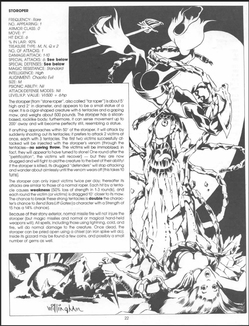
Picture: Storoper entry from Assault on the Aerie of the Slave Lords (TSR) by Bill Willingham
Part One, the overview, is here. But if you're not into D&D then what's the difference. Credits at the end.
The first model is what I think of as The Eternal Dungeon or Gauntlet Play (after the old arcade game.) I realise these titles have negative connotations.
These are the features of original D&D (OD&D) and the early TSR games like 1st edition AD&D and Basic/Red Box. They are also the features embraced by old school D&D gamers.
- sandbox principle
- level one of dungeon : level one encounters principle
- high player freedom / participation
- OD&D door principle
- heavy use of random generation / tables
- luck element of game embraced
The fact that this idea of gameplay is usually positioned against the story-based Hickman ideas doesn't mean that it has no story. Me and my brother sometimes laid out the map of Greyhawk, took the travel times and random tables then just played a journey with no DM or preamble at all. As we went, we just improvised bits of story and built on that.
This style embraces the fantasy and surreal aspect of the game. As in OD&D, doors in dungeons are not like normal doors, they are always locked or stuck, for players, but always allow for monsters to roam about as they like. Random improvisational gameplay throws up all kinds of marvelous weirdness too. I especially liked the early Fighting Fantasy gamebooks for this. There didn't have to be reasons for it, going under the old tree and finding mushroom farming clone warriors was really cool and imaginative.
James Maliszewski (Grognardia Blog):
It also embraces the idea of it being a game. You can fail the task, die or just abandon it, then just start up again or slot a new character in. It's fluid and you build the story or experience.
However, it is also very easy to fall into the monster/treasure/trap model that reminds me of the game Gauntlet. Some people love the mega-dungeon idea and why not. I myself am all for the TSR era games but I'm not wholly for the Gauntlet play either. The core principle, in my view, of the TSR original game play gets identified in part 5.
Credits
James Maliszewski (Grognardia Blog):
Matt Finch's A Quick Primer for Old School Gaming
If you then read comments and surf around, you will find a lot more discussion and materials. I have linked the main ones that I found and liked - and that I'm going to borrow from heavily.